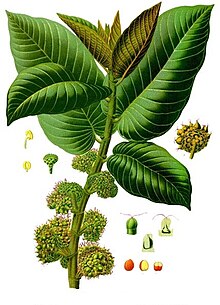Moraceae
An Moraceae — o inaapod man na mulberry family o fig family — sarong pamilya kan tanom na nagbuburak binubuo kan 38 genera asin lampas sa 1100 na espesye.[2] Kadaklan nakalakop sa tropikal asin subtropikal na mga rehiyon, igwa man nin dikit sa mga temperadong klima. An synapomorphy sa laog kan Moraceae iyo an presensiya kan mga laticifer asin malagatas na sap sa buong parenchymatous na tisyu, sa kagabsan, an katangian kaini iyo an pagkakaigwa nin duwang carpels o paminsan saro lang, surumpayan na mga burak, asin surumpayan na mga bunga.[3] Sa pamilyang ini nakaayon an mga bistong tanom arog kan Balete, banyan, breadfruit, mulberry, asinOsage orange. An mga burak kan Moraceae madalas pseudanthia (o minsan inflorescence).
| Moraceae | |
|---|---|

| |
| (Castilla elastica) | |
| Sayantipiko na klasipikasyon | |
| Kahadean: | Plantae |
| Klado: | Angiosperms |
| Klado: | Eudicots |
| Klado: | Core eudicots |
| Klado: | Rosids |
| Orden: | Rosales |
| Pamilya: | Moraceae Gaudich.[1] |
| Genera | |
|
Hilingon an teksto | |

Historical taxonomy
baguhonDati kasali sa order na Urticales, an mga bagong pag-adal an nagkaag kani sa order kan Rosales sa clade na inaapod na urticalean rosids igdi kasali man an Ulmaceae, Celtidaceae, Cannabaceae, asin Urticaceae. Cecropia, na ikinaraag sa Moraceae, Urticaceae, o sa sadiri nindang pamilya, an Cecropiaceae, kaayon na sa Urticaceae.[4]
An Dioecy (mga indibiduwal na magkasuway an kasarian) nagluluwas na may primitibong estado sa Moraceae.[5]
Distribusyon
baguhonAn mga Moraceae pwedeng mahiling sain man na parte kan kinaban, pinaghihinalaan dahil sa pagsuruwayan kan Gondwana sa panahon kan Jurassic[6]. An kadaklan kan espesye mahihiling sa lumang tropiko na igwang doon sa Asia asin mga pulo sa Pasipiko.[7]
Phylogenyo
baguhonAn modernong molecular phylogenetics itinutugma an mga relasyon na ini:[4][5][8][9]
|
| ||||||||||||||||||||||||||||||||||||||||||||||||||||||||||||||||||||||||||||||||||||||||||||||||||||||||||||||||||||||||||||||||||||||||||||||||||||||||||||||||||||||||||||||||||||||||||||||||||||||||||
Mga tribo asin genera
baguhonAn Moraceae binubuo kan:[10]
- Artocarpeae Lam. & DC. 1806
- Artocarpus J.R.Forst. & G.Forst. (~50 spp.)
- Batocarpus H.Karst. (4 spp.)
- Clarisia Ruiz & Pav. (3 spp.)
- Hullettia King ex Hook.f. (2 spp.)
- Parartocarpus Baill. (3 spp.)
- Prainea King ex Hook.f. (4 spp.)
- Treculia Decne. ex Trécul (3 spp.)
- Castilleae C.C.Berg 1977
- Antiaropsineae (C.C.Berg) Clement & Weiblen 2005
- Antiaropsis K.Schum. (1 sp.)
- Sparattosyce Bur. (1 sp.)
- Castillineae Clement & Weiblen 2009
- Antiaris Lesch. (1 sp.)
- Castilla Cerv. (3 spp.)
- Helicostylis Trécul (7 spp.)
- Maquira Aubl. (5 spp.)
- Mesogyne Engl. (1 sp.)
- Naucleopsis Miq. (~20 spp.)
- Perebea Aubl. (9 spp.)
- Poulsenia Eggers (1 sp.)
- Pseudolmedia Trécul (~9 spp.)
- Antiaropsineae (C.C.Berg) Clement & Weiblen 2005
- Dorstenieae Dumort. 1830
- Bleekrodea Blume (3 spp.)
- Bosqueiopsis De Wild. & T.Durand (1 sp.)
- Brosimum Sw. (13 spp.)
- Broussonetia L’Hér. ex Vent. (8 spp.)
- Dorstenia L. (~105 spp.)
- Fatoua Gaudich. (3 spp.)
- Helianthostylis Baill. (2 spp.)
- Malaisia Blanco 1837 (1 sp.)
- Scyphosyce Baill. (2 spp.)
- Sloetia Teijsm. & Binn. ex Kurz 1864 (1 sp.)
- Trilepisium Thouars (1 sp.)
- Trymatococcus Poepp. & Endl. (2 spp.)
- Utsetela Pellegr. (1 sp.)
- Ficeae Gaudich. 1830
- Ficus L. (750 spp.)
- Maclureae W.L. Clement & Weiblen 2009
- Maclura Nutt. (11 spp.)
- Moreae Dumort. 1829
- Fossils
Toltolan
baguhon- ↑ Angiosperm Phylogeny Group (2009). "An update of the Angiosperm Phylogeny Group classification for the orders and families of flowering plants: APG III" (PDF). Botanical Journal of the Linnean Society 161 (2): 105–121. doi:. http://onlinelibrary.wiley.com/doi/10.1046/j.1095-8339.2003.t01-1-00158.x/pdf. Retrieved on 2013-07-06.
- ↑ Christenhusz, M. J. M.; Byng, J. W. (2016). "The number of known plants species in the world and its annual increase". Phytotaxa 261 (3): 201–217. doi:. http://biotaxa.org/Phytotaxa/article/download/phytotaxa.261.3.1/20598.
- ↑ Judd WS, Campbell CS, Kellogg EA, Stevens PF, Donoghue MJ (2008). Plant Systematics: A Phylogenetic Approach. Sunderland, MA: Sinauer Associates, Inc. pp. 1–620. ISBN 978-0-878-93407-2.
- ↑ 4.0 4.1 "Urticalean rosids: Circumscription, rosid ancestry, and phylogenetics based on rbcL, trnL–F, and ndhF sequences". American Journal of Botany 89 (9): 1531–1546. 2002. doi:. PMID 21665755. http://www.bricol.net/research/CICphylog/CICfinalSTUFF/Urtical-rosids.pdf.
- ↑ 5.0 5.1 "On the origin of the fig: Phylogenetic relationships of Moraceae from ndhF sequences". American Journal of Botany 91 (5): 767–777. 2004. doi:. PMID 21653431. Archived from the original on 2021-02-13. https://web.archive.org/web/20210213101207/https://bsapubs.onlinelibrary.wiley.com/journal/15372197. Retrieved on 2019-09-09.
- ↑ Plantilya:Cite website
- ↑ Zerega NJC, Clement WL, Datwyler SL, Weiblen GD." (2005). "Biogeography and Divergence times in the mulberry family (Moraceae)". Molecular Phylogenetics and Evolution 37 (2): 402–416. doi:. PMID 16112884.
- ↑ "Morphological evolution in the mulberry family (Moraceae)". Systematic Botany 34 (3): 530–552. 2009. doi:. http://www.ingentaconnect.com/content/aspt/sb/2009/00000034/00000003/art00010.
- ↑ "Biogeography and divergence times in the mulberry family (Moraceae)". Molecular Phylogenetics and Evolution 37 (2): 402–416. 2005. doi:. PMID 16112884.
- ↑ Hepworth C. (2018). "Moraceae - The Mulberry Family". Florida Fruit Geek. https://floridafruitgeek.com/moraceae-the-mulberry-family/.